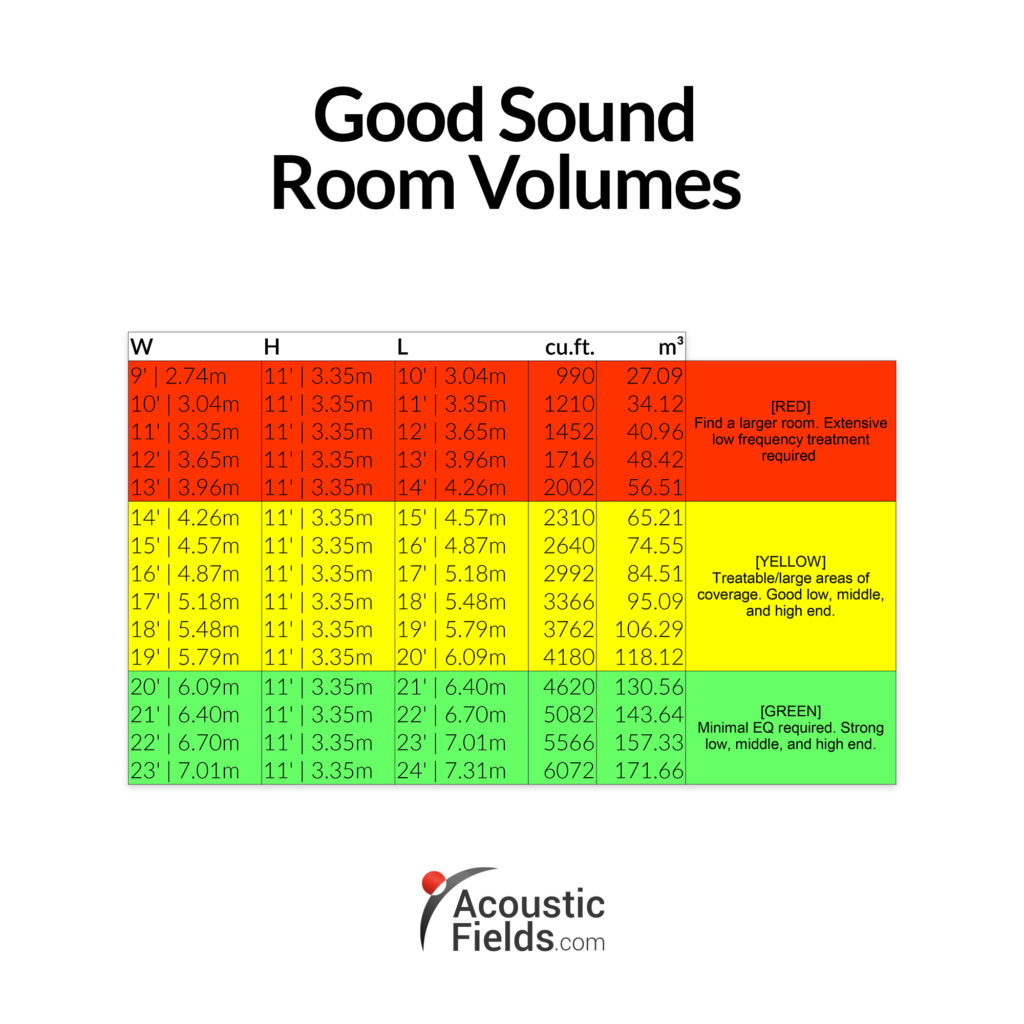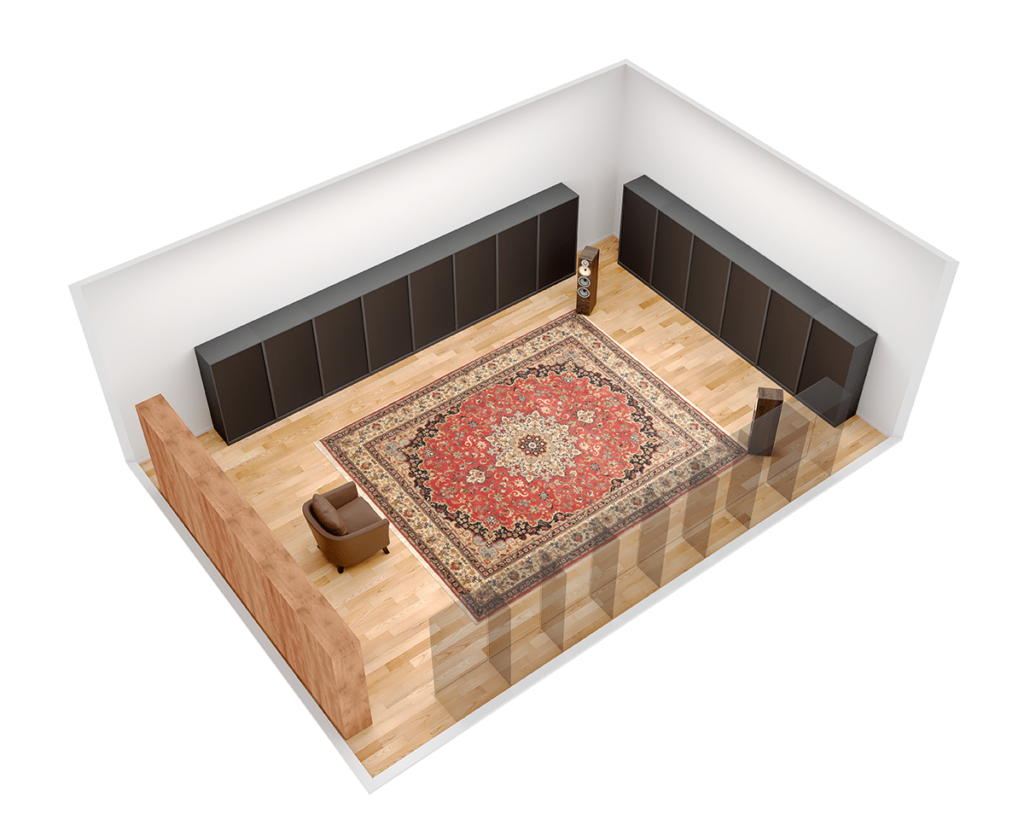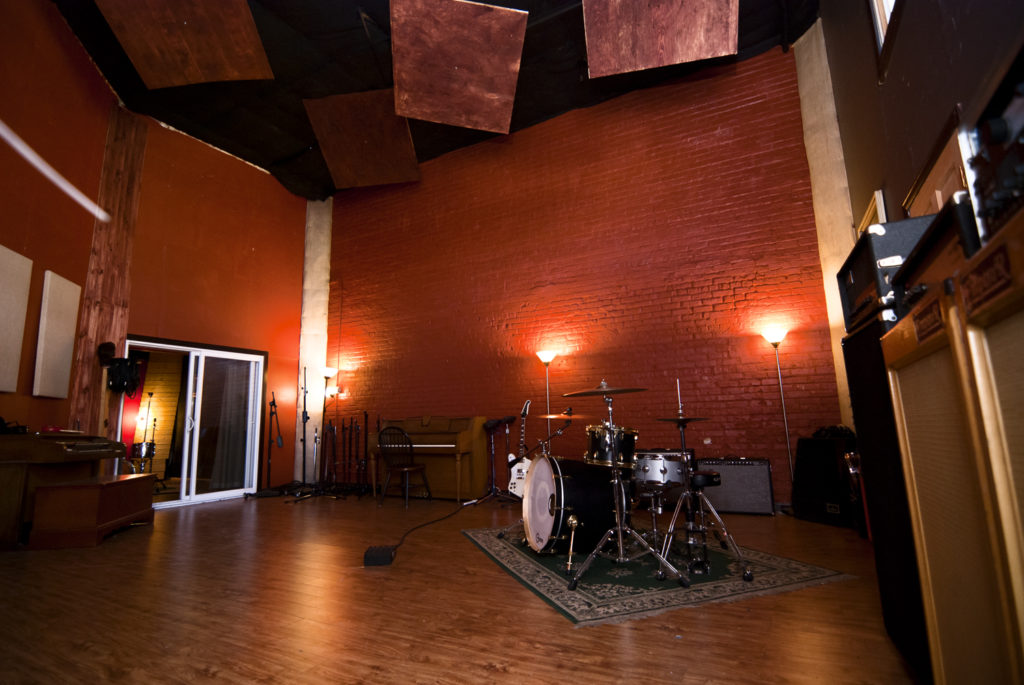The science has advanced in the area of small and larger room acoustics. We have updated this blog on 11 / 6 / 19 to reflect those changes.
Small Room Acoustics vs Large Rooms
Small rooms have certain acoustical issues that are different from large room acoustics. Large rooms have certain acoustical issues that are not found in small rooms. Assuming we use the same full range sound source in each room size, small rooms are about sound pressure raising havoc between the room boundary surfaces. Large rooms are all about reflections off of surfaces that contribute to higher reverberation times.
Small Room Acoustics
The size of our small room environment has a major impact on the acoustical issues of the room, especially at low frequencies. Certain ratios of room height, width, and length contribute to low-frequency pressure build-up areas in our small rooms and other ratios minimize those issues. The ratio selection process does not eliminate issues but a balanced ratio of the width, height, and depth can minimize the unwanted low-frequency pressure issues. These unwanted, higher pressure, low-frequency issues are termed room modes and can cause acoustical distortions at our listening or monitoring position at all frequency ranges.
Small Room Definition: https://www.thefreedictionary.com/small+room
Large Room Definition: https://www.merriam-webster.com/dictionary/great%20room
Room Modes
A room mode is a pressure build-up of energy that will not fit into the dimensions of your room. Room modes can blur and smother certain frequency ranges that we must use to listen to vocals or music. They can over-exaggerate some frequencies within the mode or can completely smother others. They are areas of pressure created by the frequency that is running against a certain room dimension that does not correspond to a ratio of wavelength to the wall to wall length. Large rooms have more distance and thus more space for lower frequency energy to live and die on their own volition.
No Modes
Large rooms do not suffer from room modal issues. They have larger distances between their room boundary surfaces and longer wavelengths get a chance to spread out or run their full wavelengths. The floor to ceiling dimension can be an issue since it is always the smallest of the three. Low-frequency energy waves can run free without striking a room boundary surface. I was in a church today that has walls that were 185′ apart. If we take a 20 cycle wave that the organ can produce and measure it, we would find it to be about 56′ long. With 185′ long distances to travel, the wave will fully form before striking any surface and thus be heard in its splendor.
Small Room Reflections
Small rooms must deal with reflections from room boundary surfaces. All of these reflections get interlaced with the direct energy from our speakers and confuse the wanted direct energy. The direct energy is the energy that travels in a straight line from the speaker to the listener. This is the actual sound. When reflections from room walls mix with the direct energy, they superimpose themselves upon the direct sound from the speakers. This delayed signal reduces source clarity and staging. There is a much smaller time window to deal with in small room acoustics than with a large room since our distances from the wall (reflection) are longer thus taking longer in time to reach our ears.
Large Room Reflections
Reflections from large room walls and ceilings, all add up to increased reverberation times. The reflections in large rooms increase the reverberation times, which plays havoc with everything. Reverberation times are the summation of all the reflections from the floor, ceiling, and walls. It mainly impacts the frequency range from 125 – 4,000 Hz., which is the range where vocals lie. This is termed the speech intelligibility range. If reverberation times exceed 1 second, then speech begins to become unintelligible very quickly. The measurement number used to determine reverberation time numbers for a room is expressed in a term called Rt-60.
Exceed One Second
If we exceed 1 second reverberation time for speech, the reflections in our large room become superimposed over the direct sound we need to hear. The direct sound is the sound that leaves from a source such as our loudspeaker and travels directly to the receiver’s ear. This is a purer sound since it is a straight line without any room reflections or distortion. It is the straight line sound that does not have any room reflections interlaced with it to confuse and muddle the direct sound.
Reverberation Everywhere
No matter where one sits, the reverberation times blur and confuse the signal. This produces room acoustic distortions and the direct sound becomes unintelligible. Churches built 50 years ago are a good example of large room acoustics and usually high reverberation times. It is difficult to hear the pastor when he gives the sermon. When the choir starts to sing there may be spiritual salvation but acoustically, all is lost. Trying to separate vocals from music is difficult.
Stereo Signal In Small Rooms
Most sound systems that are placed in small rooms are stereo or multiple channel systems such as home theater or simply two-channel stereo. A stereo signal is composed of a signal that is designed to produce an image that has depth and definition. A properly set up two-channel system will produce a sound image that can extend wider than the physical distance between the left and right channel speakers. This is what audiophiles refer to as the sound stage. It can have a width, depth, height to the audio presentation even though the whole image is produced by just two speakers.
Sound Stage Impact
Reflections off of the side walls in small room acoustical setups have a direct impact on the sound stage. If the sidewall reflections are not delayed enough in time below the 20 ms. mark, then sound stage image will suffer. We will also receive an image shifting if there are unequal distances between the side walls. Even the density or structure of the wall needs to be the same. The sound stage image will be pulled towards the shorter sidewall distance dimension if distances do not match.
No Sound Stage
Sidewall reflections, in larger room acoustical situations, add to the room’s overall reverberation times. There is no sound stage created between the speakers in a large room environment. The signal is mono and is not designed to create depth and direction. The mono signal is intended to project the sound out in a straight line array that matches the use and need of the building. Many speakers may be needed to allow for adequate sound coverage in the given large room size.
Multiple Mono Sources
In some large room acoustical situations, the area to be covered with sound is large and the rooms reverberation times are too high. One method for dealing with this is to use multiple speakers with tighter dispersion patterns across the sound surface area, say of a congregation. The smaller radiation area pattern produced by multiple speakers positioned in specific areas for coverage produces direct sound in shorter patterns but one still has the high reverberation times within the room to deal with.
Small rooms have similar acoustical issues as large rooms just on a different scale and level. Small room surface boundary reflections, especially from side walls, can play havoc with our sound stage presentation in a two-channel system. We can have image shifting and image size reduction. Large room reflection issues contribute to the overall reverberation levels and confuse the direct sound from our mono source. Low-frequency issues are predominant in small rooms, where larger rooms have the physical space for lower frequency wavelengths to extend themselves.
In Summary
I hope this explanation helped. If you want to learn more about this subject please sign up for our free room acoustic treatment videos and ebook which provide step by step instructions. Get instant access by signing up now.
Thanks









in regards to lowest theoretical bass frequency that a room can handle/produce, is it the furthest distance of 2 parallel walls/surfaces or the max point to point distance e.g. hypotenuse of square or rectangle? a 10x10ft room would be 14.14ft, 110hz vs 80hz for full wavelength even though room modes and ceiling height add another variable to yet another equation.
B, Use the furthest distance for two parallel walls (axial).
In the article you say,
” Certain ratios of room height, width, and length contribute to low-frequency pressure build-up areas in our small rooms and other ratios minimize those issues. The ratio selection process does not eliminate issues but a balanced ratio of the width, height, and depth can minimize the unwanted low-frequency pressure issues.”
Are you implying that a room with measurements approaching a symmetrical cube is more amenible to sound treatment compared to one that is not symmetrical. For instance, my office is small (~1450 c.f.) but is 11x11x12′ in dimension. Is it a viable candidate for treatment?
All rooms are treatable. The dimensions will determine how effective the treatment will be.